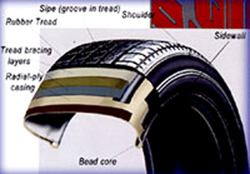Tyres are the only parts of the vehicle, which are in contact with the road. Safety in acceleration, breaking, steering, and cornering – all depends on relatively small area of the road contact.
It is therefore of paramount importance that tyre should be maintained in good condition at all times.
- Maintain correct inflation pressure.
- Check periodically for misalignment, balance, and mechanical irregularities.
- Regular maintenance of steering and suspension components.
- Avoid harsh braking, rapid acceleration, and fast cornering.
- Do not overload.
- Retread the tires with Teeson precured Treads.









